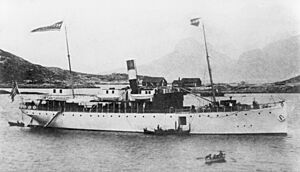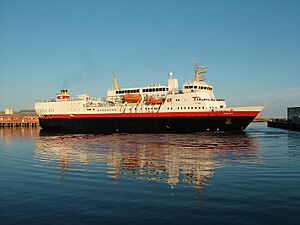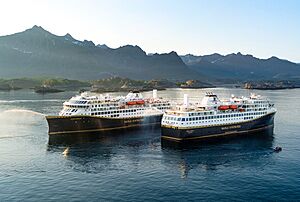Hurtigruten facts for kids
The Hurtigruten (which means Express Route) is a famous coastal ship service in Norway. It's also known as the "coastal route Bergen-Kirkenes". These ships carry both people and cargo along Norway's long coastline.
The Hurtigruten sails every day, all year round, between Bergen in the south and Kirkenes in the far north. It stops at 34 different ports when going north and 33 ports when going south. The ships are big enough to carry many passengers and lots of cargo. For a long time, different shipping companies ran this route. In 2006, two main companies, OVDS and TFDS, joined together to form a new company called Hurtigruten AS. Since 2021, another company, Havila Kystruten AS, also operates ships on this route. To keep the daily service going, 11 ships are needed. Hurtigruten AS operates seven of these ships, and Havila Kystruten operates four.
In 2022, one of Havila Kystruten's ships, the MS Havila Capella, had to stop sailing for a short time. This was because of international rules related to events in Ukraine, which affected the ship's insurance. The problem was fixed by June 2022, and the ship could sail again.
Contents
History of the Express Route
The Hurtigruten started in 1893. The Norwegian government wanted to make it easier for people to travel and send mail along Norway's long, winding coast. The first ship, Vesteraalen, began its journey on July 2, 1893, from Trondheim. It sailed north to Hammerfest, stopping at many towns along the way.
This first trip was commanded by Richard With, who helped create the route. It was the fastest way to travel between northern and southern Norway at the time. That's why it was named "Hurtigruten," meaning "Express Route." For example, a trip from Trondheim to Hammerfest that used to take weeks could now be done in just a few days.
Before Hurtigruten, sailing along the coast was very difficult, especially in winter. The waters were not well mapped. The company that started Hurtigruten, Vesteraalens Dampskibsselskab, made special maps to help their ships navigate safely. The Hurtigruten was a huge help for the towns along its path. Mail delivery became much faster, changing how people lived and worked.
Because the first trips were so successful, other shipping companies also started operating on the route. The route was extended to go all the way from Bergen to Kirkenes. Soon, a fleet of 11 ships was visiting each of the 34 ports every day, both going north and south.
For many years, especially before the 1960s, roads didn't reach many towns north of Trondheim. So, the sea was the only way to get there. But as more airports and better roads were built, the Hurtigruten's role changed. It became more focused on tourism. In the 1980s, new, larger, and more comfortable ships were built. These ships had things like hot tubs, bars, and nice restaurants for travelers. Even today, the Hurtigruten is important for both passengers and cargo, and it operates every single day of the year.
In 2006, the last two independent companies running the Hurtigruten merged to become the Hurtigruten Group. This company later became Hurtigruten ASA.
New Ships and Upgrades
In 2017, the Norwegian government decided to divide the Hurtigruten service into three separate contracts. Two contracts went to Hurtigruten AS, and one went to Havila Kystruten AS. This means that the two companies now share the daily departures from Bergen to Kirkenes.
Havila Kystruten introduced four brand-new ships. These ships are special because they use both natural gas (LNG) and batteries for power. Using LNG helps reduce pollution by 25%, and the batteries save even more energy. These new ships are named Havila Capella, Havila Castor, Havila Polaris, and Havila Pollux. They were all built in Turkey.
Hurtigruten AS also updated and improved its existing ships to meet the new requirements. Ships like |MS Midnatsol, MS Trollfjord, and MS Finnmarken were modernized. They received new Scandinavian-style interiors. These ships were also fitted with special filters and engines that can use LNG. This helps them reduce their emissions by 25%. They also got hybrid engines and battery packs, making them more environmentally friendly.
Current Fleet of Ships
As of 2024, here are the ships sailing on the Hurtigruten route:
| Name | Built | Gross tonnage | Operator | Image | Ref |
|---|---|---|---|---|---|
| MS Vesterålen | 1983 | 6,261 | Hurtigruten AS |  |
|
| MS Kong Harald | 1993 | 11,204 | Hurtigruten AS |  |
|
| MS Richard With | 1993 | 11,205 | Hurtigruten AS | 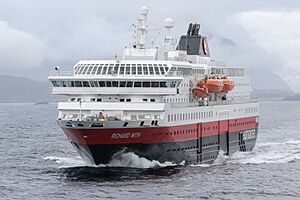 |
|
| MS Nordlys | 1994 | 11,204 | Hurtigruten AS | 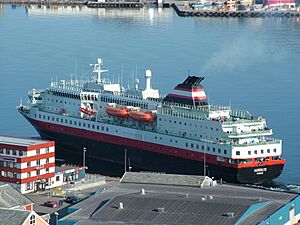 |
|
| MS Polarlys | 1996 | 11,341 | Hurtigruten AS | 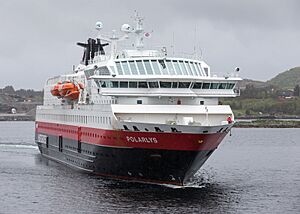 |
|
| MS Nordkapp | 1996 | 11,386 | Hurtigruten AS | 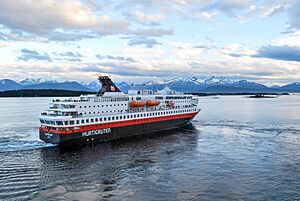 |
|
| MS Nordnorge | 1997 | 11,384 | Hurtigruten AS | 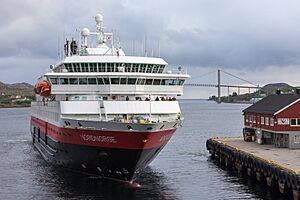 |
|
| MS Havila Capella | 2021 | 15,519 | Havila Kystruten | 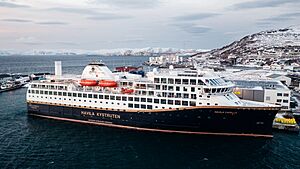 |
|
| MS Havila Castor | 2022 | 15,519 | Havila Kystruten | 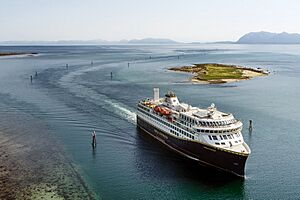 |
|
| MS Havila Polaris | 2023 | 15,519 | Havila Kystruten | 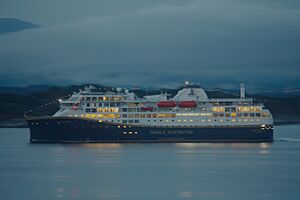 |
|
| MS Havila Pollux | 2023 | 15,519 | Havila Kystruten | 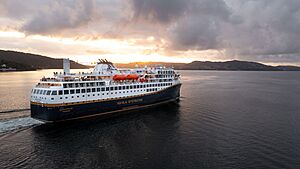 |
Places the Ships Visit
Here are the places the Hurtigruten ships visit when sailing northbound:
- Bergen
- Florø
- Måløy
- Torvik
- Ålesund
- Geiranger (only in summer)
- Urke, Ørsta (only in September & October)
- Molde
- Kristiansund
- Trondheim
- Rørvik
- Brønnøysund
- Sandnessjøen
- Nesna
- Ørnes
- Bodø
- Stamsund
- Svolvær
- Stokmarknes
- Sortland
- Risøyhamn
- Harstad
- Finnsnes
- Tromsø
- Skjervøy
- Øksfjord
- Hammerfest
- Havøysund
- Honningsvåg
- Kjøllefjord
- Mehamn
- Berlevåg
- Båtsfjord
- Vardø
- Vadsø
- Kirkenes
Hurtigruten on TV
In 2011, the Norwegian Broadcasting Corporation (NRK) showed the entire 134-hour journey of the Hurtigruten ship MS Nordnorge from Bergen to Kirkenes. This was part of their "slow television" series, where they broadcast long, real-time events. The broadcast started on June 16, 2011, and allowed viewers to experience the whole trip.
Past Incidents
Over the years, like any long-running transport service, the Hurtigruten has had some incidents. Before World War II, some ships ran aground, often because of bad weather or poor visibility. Many Hurtigruten ships were sunk during World War II.
After the war, there were a few notable events:
- In September 1954, the ship SS Nordstjernen hit the ground at night and sank. Five people on board passed away.
- On January 8, 1958, a fire started on the MS Erling Jarl while it was docked in Bodø. Sadly, some people died from breathing in smoke. Today, there is a memorial in Bodø to remember this event.
- On October 21, 1962, the MS Sanct Svithun hit a reef after leaving Trondheim due to a navigation mistake. Some people on board did not survive.
- In 2011, the MS Nordlys had a fire in its engine room, which resulted in the deaths of two crew members.



